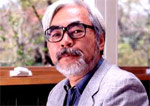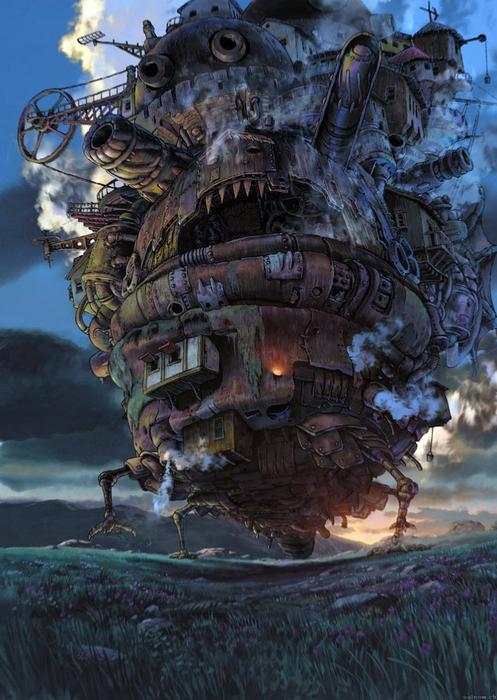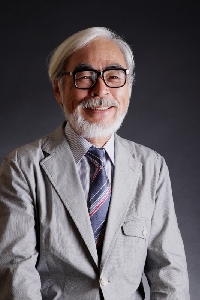 With Miyazaki Hayao in town to receive the Berkeley Japan Prize from The Center of Japanese Studies at the University of Califoria, Berkeley, the center has been in full swing to discuss Miyazaki's work as an artist and an intellectual. On the morning of July 25, eight hours before Miyazaki gave his speech to a sold out audience in Berkeley's Zellerbach hall, three scholars got together at the East Asian Studies department's conference room to discuss the academic side of Miyazaki's use of technology and children in his films.
With Miyazaki Hayao in town to receive the Berkeley Japan Prize from The Center of Japanese Studies at the University of Califoria, Berkeley, the center has been in full swing to discuss Miyazaki's work as an artist and an intellectual. On the morning of July 25, eight hours before Miyazaki gave his speech to a sold out audience in Berkeley's Zellerbach hall, three scholars got together at the East Asian Studies department's conference room to discuss the academic side of Miyazaki's use of technology and children in his films.
Dr. LaMarre introduced attendees to Miyazaki's peculiar association with technology. He explains that Miyazaki is at once in love with the wonder technology can bring, but at the same time hates their conventional use in modern culture. LaMarre believes that his strong disassociation with current otaku is a by-product of how Miyazaki does not agree with the bulk of what animators in Japan consider and create as anime today. It is well known that Miyazaki does not call his works “anime,” but “manga douga” (moving comics). His attempt to escape from the standard fare of mecha and other technology leads him to reinvent technology in his films, mixing a sense of steam-punk or retro with fantastic machinery.
Miyazaki also is noted to not like telling a simple “good” versus “evil” story. Miyazaki's films show that technology cannot be taken away from evil forces, nor should the good guys monopolize it. According to LaMarre, the greatest reason why Miyazaki and Tezuka (who created Astro Boy) were at odds in their work was this.
 To this, LaMarre finds that Miyazaki's Castle in the Sky is the turning point for Miyazaki's work. Castle in the Sky is reminiscent of Miyazaki's older works, and serves as a transition between his work as a commercial animator, to an artist that may work on his own vision. In this story, Miyazaki shows that the heros do not prevail because of technology, nor do they gain it, but LaMarre stresses that technology does not simply fade away. Children, he claims, are who should steer themselves on how to deal with technology to impede self-destruction.
To this, LaMarre finds that Miyazaki's Castle in the Sky is the turning point for Miyazaki's work. Castle in the Sky is reminiscent of Miyazaki's older works, and serves as a transition between his work as a commercial animator, to an artist that may work on his own vision. In this story, Miyazaki shows that the heros do not prevail because of technology, nor do they gain it, but LaMarre stresses that technology does not simply fade away. Children, he claims, are who should steer themselves on how to deal with technology to impede self-destruction.
In what is often seen as the apocalyptic vision of the human race, technology inevitably leads to the self destruction of mankind. What Miyazaki then tries to show is a story with no definite ending. The technology is there and people have to deal with it, for better or worse without losing sight of what the human race is.
Shamoon changed the focus from technology to the depiction of children in Miyazaki's films and Japanese film in general. In Shamoon's case, children serve as a connection to nature and magic for Miyazaki. Their depiction on the film plays as an anchor to help adults get in touch with the movie's themes. She argues that true children and their thoughts would be far too foreign and too hard to decipher.
As an example, Shamoon provided several examples of children depicted in films. Whether the medium be in animation or film, the children are written in a way that they act as a vessel of meaning that adults can find relation too. In the film Nobody Knows by Kore-eda Hirokazu, Kore-eda used almost no script and used children with no acting experience to shoot the film. The acting by the children were thus, almost not acts. The film by Kore-eda, as Shamoon explains, is harder to be grasped by adults because the acting by the children are, at times, far too confusing to an adult mind. Thus, Shamoon believes that Miyazaki, as family oriented as his films may be, does not write truly convincing children into his films.
 Schodt, while not an expert on Miyazaki, took half an hour or so to discuss his thoughts on him. He had just finished translating a book written by Miyazaki, and shared his own insights into the man that he spent an year translating and studying. His key belief in Miyazaki was simple: “Miyazaki is a very honest and frank man.” For all things considered, Schodt finds Miyazaki's blunt honesty refreshing. Schodt explains through a reading from the book that Miyazaki is critical of others, but also of himself. He also shows that Miyazaki is revered for his works, but reveres others just as much in compassion.
Schodt, while not an expert on Miyazaki, took half an hour or so to discuss his thoughts on him. He had just finished translating a book written by Miyazaki, and shared his own insights into the man that he spent an year translating and studying. His key belief in Miyazaki was simple: “Miyazaki is a very honest and frank man.” For all things considered, Schodt finds Miyazaki's blunt honesty refreshing. Schodt explains through a reading from the book that Miyazaki is critical of others, but also of himself. He also shows that Miyazaki is revered for his works, but reveres others just as much in compassion.
The talk finished up with a Q&A session from the audience. The Q&A session was largely based on post-modernist BS theory. Hard words strung together in a haphazard fashion were thrown around the room stunning both the panelists and the audience with how much BS can be spewed from the mouth at once. Nothing of real merit was said during these last 20 minutes.
